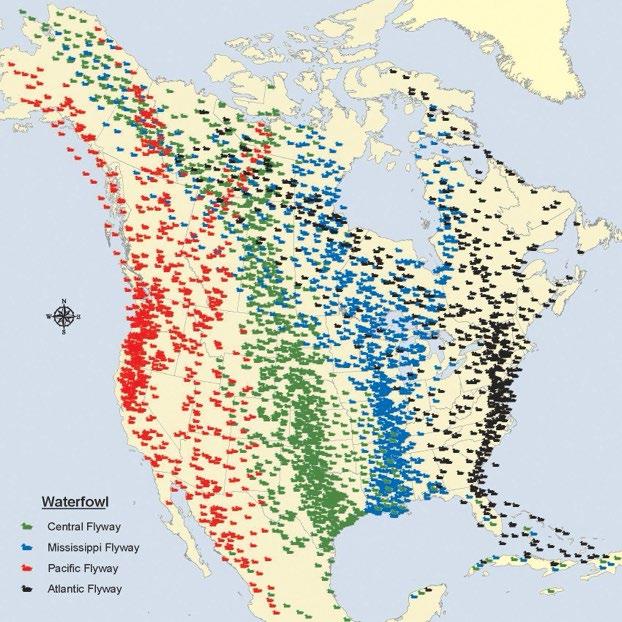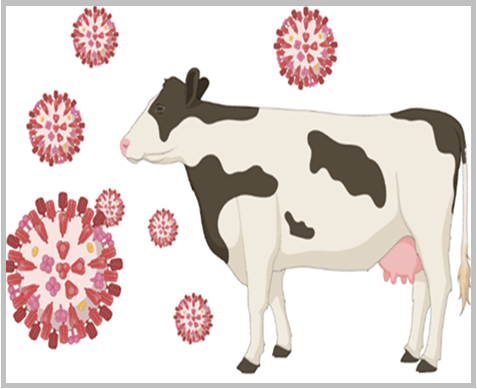RECENT DETECTIONS OF AVIAN INFLUENZA IN DAIRY COWS: WHAT YOU NEED TO KNOW?
Madhusudan Timilsina DVM, MS, and Mostafa Ghanem DVM, MS, Ph.D., Department of Veterinary Medicine, University of Maryland
On March 25, 2024, highly pathogenic avian influenza (HPAI) was detected in diagnostic samples from two dairy cattle farms in Texas and two in Kansas. This significant finding was announced jointly by the U.S. Department of Agriculture (USDA), Food and Drug Administration (FDA), and Centers for Disease Control and Prevention (CDC). Notably, this marks the first instance of HPAI detection in dairy cattle and the second instance in ruminants. Previously, the virus had been identified in juvenile goats on a Minnesota farm. The complete press release from the USDA is here.
What is Highly Pathogenic Avian Influenza?
Highly Pathogenic Avian Influenza (HPAI), commonly known as bird flu, is an infectious disease affecting poultry. It is caused by a virulent subtype of type-A influenza virus. While commercial chickens suffer severe and often fatal consequences, wild birds such as ducks, geese, swans, and shorebirds can carry and spread the disease over vast geographic areas without showing symptoms. During their annual migrations, these wild birds introduce the virus to susceptible domestic poultry flocks. Although domestic chickens, turkeys, quails, and other poultry species are at risk, humans, and other mammals (such as pigs and cattle) are infrequently infected, exhibiting varying degrees of clinical signs.
Why is the recent HPAI detection in Texas and Kansas dairy farms concerning?
It represents the first documented case of HPAI infection in dairy cattle and the second occurrence in ruminants. This recent finding may indicate potential changes in host-range and transmission dynamics. However, fortunately initial testing by the National Veterinary Services Laboratories has not revealed any genetic alterations that would increase virus transmissibility to humans, keeping the risk to the public low. However, the impact on cattle health, particularly milk production and quality could be affected significantly if it is not properly controlled.
What are the symptoms of this disease in cattle?
In chicken this disease is associated with high mortality and acute development of sever clinal signs (head swelling and discoloration, respiratory distress, watery green diarrhea, and neurological symptoms like neck twisting or unsteady gait). This has not been seen in cattle, where the following signs are reported.
• Reduced ruminations, feed intake, and milk production especially in second lactation and older cows, typically over 150 days in milk.
• Milk from affected animals has an unusual appearance, resembling thick, yellow colostrum.
• The manure of infected cattle tends to be firm and tacky. Additionally, some cows may or may not exhibit fever.
• Approximately 10% of the herd is affected, with a peak incidence occurring around 3-4 days. The outbreak typically lasts for about 10-14 days.
• Fortunately, few cows may die from the disease. However, many affected cows end up being culled due to reduced production or mastitis.
Has there been any detection of HPAI in Maryland cattle?
As of now, there is no evidence of HPAI infection in cattle or other ruminants within the state of Maryland. While state diagnostic laboratories have the capability to test samples from suspected cattle, prior authorization from the state veterinarian is required. Farmers and veterinarians are strongly encouraged to promptly report any cattle exhibiting suspected illnesses to the state veterinarian’s office. This proactive reporting helps monitor potential additional cases and minimizes the impact on farmers, consumers, and other animals.
What are the transmission routes and risk factors of HPAI spread to the cattle?

The introduction of HPAI to cattle appears to be linked to wild birds, as evidenced by the presence of dead birds on cattle premises. However, there has been no formal study on direct transmission from one cow to another. Generally, as a mammal, cattle are considered dead-end hosts for the disease. The susceptibility of older dairy cattle remains a puzzle, as the biological reasons behind their increased vulnerability are not yet fully understood. In birds, the HPAI virus spreads through various routes, including direct and indirect contact, aerosols, contaminated surfaces (fomites), personnel handling, contaminated food, water, and even via insects and rodents.
Is the virus transmissible to humans?
Mammals, including cattle, do not spread bird flu to humans. Therefore, the risk of getting infected from diseased cattle remains low. Initial studies by the National Veterinary Service Laboratories (NVSL) have not found changes in the virus that would make it more transmissible to humans. Thus, the risk of infection to the public remains minimal.
Is the consumption of milk and meat safe?
Yes, properly preserved, and cooked milk and meat are safe to eat. Dairies are required to send only milk from healthy animals into processing for human consumption. Pasteurization is mandatory for any milk entering interstate commerce. Milk from impacted animals is either diverted or destroyed to prevent it from entering the food supply. Additionally, pasteurized milk, heated at 161.5ºF for 15 seconds, effectively destroys the influenza virus, ensuring the safety of milk consumption. The disease has not been detected in beef cattle, and properly cooked beef remains completely safe for human consumption.
How to prevent the spread of the HPAI in the dairy farm?
To reduce the risk of HPAI in the cattle farms, strict biosecurity measures are crucial. This includes limiting wild bird contact with animals, feed and water on the farm, limiting farm access to only the essential personnel, implementing enhanced biosecurity protocols as per the National Dairy FARM Program (NDFP) guidelines, and providing thorough training to workers on hygiene and disease prevention. Additional biosecurity resources for milk producers can be found here and wild bird management practices are here.
What should a farmer do if they suspect their herd is affected?
Dairy farms should keep an eye out for any signs in their cattle that match the clinical description of this illness. If they notice anything concerning it, they should reach out to their veterinarian immediately. They will assess the situation and take appropriate action. The veterinarian will inform the office of the state veterinarian about the suspected infection. The state veterinarian will provide the guidelines to ensure that proper steps are taken for reporting and identification.
Currently, no regulatory control actions are advised by the USDA. However, this situation is being closely monitored and updates will be provided as more information becomes available.
Are further investigations underway to unravel the complete scenario?
Ongoing investigations are being conducted to comprehensively understand the transmission pathways of the avian influenza virus from wild birds to livestock. Additional testing is in progress to gain a thorough understanding of the epidemiological situation. Additionally, genome sequencing is underway to accurately characterize the strains of influenza viruses causing the infections.
Message to Poultry Growers
In summary, recent detections of HPAI in dairy cattle highlight the need for strict biosecurity measures on cattle farms as well as extra vigilance from the poultry growers. Poultry growers in the proximity to cattle farm should remain cautious and take more proactive biosecurity measures by limiting the access, disinfecting the vehicles and equipment entering premises and prohibiting the entry of personnel who has come in contact with the infected cattle farm.
References:
1. https://www.aphis.usda.gov/aphis/newsroom/news/sa_by_date/sa-2024/hpai-cattle
2. https://www.texasagriculture.gov/News-Events/Article/9953/COMMISSIONER-MILLER-PROVIDES-UPDATE-ON-HIGHLY-PATHOGENIC-AVIAN-INFLUENZA-DETECT
3. https://www.nmpf.org/joint-dairy-organization-statement-on-highly-pathogenic-avian-influenza-in-cows/
4. https://aabp.org/resources/2024/2024_3_25_AABP_Dairy_Cattle_Press_Release.pdf
5. https://www.avma.org/news/press-releases/highly-pathogenic-avian-influenza-detected-tx-ks-dairy-cattle
6. https://www.bovinevetonline.com/news/industry/breaking-mystery-illness-impacting-texas-kansas-dairy-cattle-confirmed-highly
7. https://dairy.osu.edu/sites/dairy/files/imce/PDF/Dairy%20Cattle%20HPAI%20Factsheet%20%231%20Final.pdf
